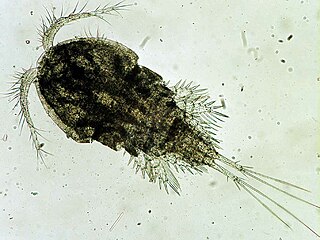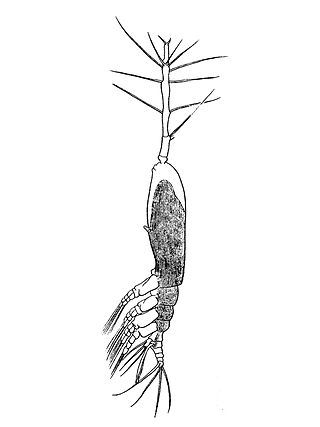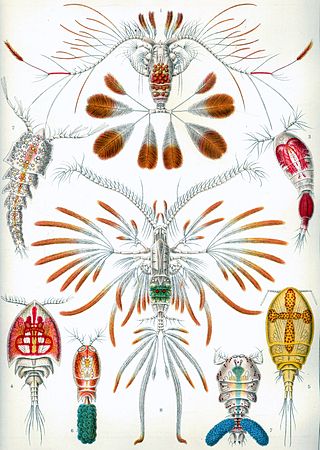
Herring are forage fish, mostly belonging to the family of Clupeidae.

Copepods are a group of small crustaceans found in nearly every freshwater and saltwater habitat. Some species are planktonic, some are benthic, a number of species have parasitic phases, and some continental species may live in limnoterrestrial habitats and other wet terrestrial places, such as swamps, under leaf fall in wet forests, bogs, springs, ephemeral ponds, and puddles, damp moss, or water-filled recesses (phytotelmata) of plants such as bromeliads and pitcher plants. Many live underground in marine and freshwater caves, sinkholes, or stream beds. Copepods are sometimes used as biodiversity indicators.

Harpacticoida is an order of copepods, in the subphylum Crustacea. This order comprises 463 genera and about 3,000 species; its members are benthic copepods found throughout the world in the marine environment and in fresh water. A few of them are planktonic or live in association with other organisms. Harpacticoida represents the second-largest meiofaunal group in marine sediments, after nematodes. In Arctic and Antarctic seas, Harpacticoida are common inhabitants of sea ice. The name Harpacticoida comes from the Greek noun harpacticon and the suffix -oid and means reminiscent of a predator.

Calanoida is an order of copepods, a group of arthropods commonly found as zooplankton. The order includes around 46 families with about 1800 species of both marine and freshwater copepods between them.

The Cyclopoida are an order of small crustaceans from the subclass Copepoda. Like many other copepods, members of Cyclopoida are small, planktonic animals living both in the sea and in freshwater habitats. They are capable of rapid movement. Their larval development is metamorphic, and the embryos are carried in paired or single sacs attached to first abdominal somite.

Poecilostomatoida are an suborder of copepods. Although it was previously considered a separate order, recent research showed it to be nested within the Cyclopoida

Monstrilloida is an order of copepods with a cosmopolitan distribution in the world's oceans. The order contains a single family, Monstrillidae. The name of the first ever described genus Monstrilla is derived from latin, meaning "tiny monster", because the lack of usual diagnostic features of copepods puzzled early taxonomists.
Syndinium is a cosmopolitan genus of parasitic dinoflagellates that infest and kill marine planktonic species of copepods and radiolarians. Syndinium belongs to order Syndiniales, a candidate for the uncultured group I and II marine alveolates. The lifecycle of Syndinium is not well understood beyond the parasitic and zoospore stages.

Platycopiidae is a family of copepods. Until the description of Nanocopia in 1988, it contained the single genus Platycopia. It now contains four genera, three of which are monotypic; the exception is Platycopia, with 8 species.

Crellidae is a family of marine demosponges in the order Poecilosclerida.
Ellobiopsis is a genus of unicellular, ectoparasitic eukaryotes causing disease in crustaceans. This genus is widespread and has been found infecting copepods from both marine and freshwater ecosystems. parasitism has been seen to interfere with fertility in both sexes of copepods.

Petrosia ficiformis, commonly known as the stony sponge, is a species of petrosiid sea sponge in the order Haplosclerida.

Petrosiidae is a family of sponges, first described in 1980 by Rob van Soest which contains the following four genera:

Crella is a genus of marine demosponges in the family Crellidae.
Crella elegans is a species of marine demosponges in the family Crellidae found in the Adriatic. It is the type species of its genus. It is the host of the ectoparasitic copepod Cryptopontius capitalis.

Artotrogidae is a family of copepods in the order Siphonostomatoida.

Cryptopontius is a genus of copepods in the family Artotrogidae.

Ramisyllis multicaudata is a species of polychaete worm in the family Syllidae. It was found in Darwin Harbour, Australia, where it was living within the tissues of a sponge of the genus Petrosia. It was the second branching species of polychaete worm to have been discovered, the first having been Syllis ramosa, a deep water species, more than a century earlier. In 2022, a second species in R. multicaudata's genus, Ramisyllis kingghidorahi, was described from specimens taken off the coast of Sado Island, Japan.

Petrosia is a genus of sponges belonging to the family Petrosiidae.
Ramisyllis kingghidorahi is a species of polychaete worm in the family Syllidae. The species lives in the Sea of Japan off Sado Island, Japan, where the holotype was found living within the internal canals of a sponge of the genus Petrosia.













